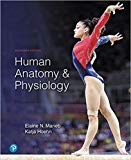
To review:
The match of bones from column B with their description in column A.
Column A 1.connected by the coronal suture. 2.keystone bone of cranium. 3.form the hard palate. 4.allows the spinal cord to pass. 5.forms the chin. 6.contain paranasal sinuses. 7.contains mastoid sinuses. |
Column B (a) ethmoid. (b) frontal. (c)mandible. (d)maxillary. (e)occipital. (f)palatine. (g)parietal. (h) sphenoid. (i) temporal. |
Answer to Problem 1RQ
Solution:
| Description (column A) | Bone (column B) |
| Connected by the coronal suture | Frontal and parietal |
| Keystone bone of cranium | Sphenoid |
| Form the hard palate | Maxillary and palatine |
| Allows the spinal cord to pass | Occipital |
| Forms the chin | Mandible |
| Contain paranasal sinuses | Ethmoid, frontal, maxillary, and sphenoid |
| Contains mastoid sinuses | Temporal |
Explanation of Solution
1. The parietal bones are curved, large, and rectangular in shape. They formthe superior and lateral aspects of the skull. The parietal bones communicate with the coronal suture. The parietal bones and the frontal bone meet anteriorly in the coronary suture.
2. The sphenoid bone is a prominent, wedge-shaped, and irregular bone located at the base of the skull. It is known as the keystone of the cranial floor. This is so because the sphenoid bone is in contact with the other cranial bones.
3. The maxilla is known to be the keystone of the facial bones. It is so called because it anchors all the facial bones apart from the mandible. It contains two maxillary bones that are fused together at the midline.
4. The hard palate is a horizontal, bony plate of the skull. It is thin and located on the roof of the mouth. The hard palate is formed by the maxilla and the palatine bone. The palatine bone is an L-shaped and paired bone that forms a part of the hard palate.
5. The occipital bone is a trapezoid-shaped bone that is located in the lower back region of the cranium. It consists of seven bones that come together to create the skull. It allows the spinal cord to pass.
6. The mandible is the largest and the strongest bone of the human face. It is also the lowest bone present in the face of human beings. The mandible forms the lower jaw and holds the teeth in place..
7. The ethmoid sinus is located in the spongy ethmoid bone in the upper region of the nose between the eyes. The frontal sinuses are present in the frontal bone and form the lower region of the forehead. The maxillary sinus is present in the cheek area next to the nose. The sphenoid sinus is present at the back of the nose between the eyes.
8. The temporal bones are located at the sides and the base of the skull. They form the inferolateral aspects of the skull and an area of the cranial base. The tympanic part of the temporal bone is present around the ear canal.
Want to see more full solutions like this?
Chapter 7 Solutions
Human Anatomy & Physiology Plus Modified Mastering A&P with Pearson eText -- Access Card Package 11th edition
- The following table is from Kumar et. al. Highly Selective Dopamine D3 Receptor (DR) Antagonists and Partial Agonists Based on Eticlopride and the D3R Crystal Structure: New Leads for Opioid Dependence Treatment. J. Med Chem 2016.arrow_forwardThe following figure is from Caterina et al. The capsaicin receptor: a heat activated ion channel in the pain pathway. Nature, 1997. Black boxes indicate capsaicin, white circles indicate resinferatoxin. You are a chef in a fancy new science-themed restaurant. You have a recipe that calls for 1 teaspoon of resinferatoxin, but you feel uncomfortable serving foods with "toxins" in them. How much capsaicin could you substitute instead?arrow_forwardWhat protein is necessary for packaging acetylcholine into synaptic vesicles?arrow_forward
- 1. Match each vocabulary term to its best descriptor A. affinity B. efficacy C. inert D. mimic E. how drugs move through body F. how drugs bind Kd Bmax Agonist Antagonist Pharmacokinetics Pharmacodynamicsarrow_forward50 mg dose of a drug is given orally to a patient. The bioavailability of the drug is 0.2. What is the volume of distribution of the drug if the plasma concentration is 1 mg/L? Be sure to provide units.arrow_forwardDetermine Kd and Bmax from the following Scatchard plot. Make sure to include units.arrow_forward
- Choose a catecholamine neurotransmitter and describe/draw the components of the synapse important for its signaling including synthesis, packaging into vesicles, receptors, transporters/degradative enzymes. Describe 2 drugs that can act on this system.arrow_forwardThe following figure is from Caterina et al. The capsaicin receptor: a heat activated ion channel in the pain pathway. Nature, 1997. Black boxes indicate capsaicin, white circles indicate resinferatoxin. a) Which has a higher potency? b) Which is has a higher efficacy? c) What is the approximate Kd of capsaicin in uM? (you can round to the nearest power of 10)arrow_forwardWhat is the rate-limiting-step for serotonin synthesis?arrow_forward
 Human Anatomy & Physiology (11th Edition)BiologyISBN:9780134580999Author:Elaine N. Marieb, Katja N. HoehnPublisher:PEARSON
Human Anatomy & Physiology (11th Edition)BiologyISBN:9780134580999Author:Elaine N. Marieb, Katja N. HoehnPublisher:PEARSON Biology 2eBiologyISBN:9781947172517Author:Matthew Douglas, Jung Choi, Mary Ann ClarkPublisher:OpenStax
Biology 2eBiologyISBN:9781947172517Author:Matthew Douglas, Jung Choi, Mary Ann ClarkPublisher:OpenStax Anatomy & PhysiologyBiologyISBN:9781259398629Author:McKinley, Michael P., O'loughlin, Valerie Dean, Bidle, Theresa StouterPublisher:Mcgraw Hill Education,
Anatomy & PhysiologyBiologyISBN:9781259398629Author:McKinley, Michael P., O'loughlin, Valerie Dean, Bidle, Theresa StouterPublisher:Mcgraw Hill Education, Molecular Biology of the Cell (Sixth Edition)BiologyISBN:9780815344322Author:Bruce Alberts, Alexander D. Johnson, Julian Lewis, David Morgan, Martin Raff, Keith Roberts, Peter WalterPublisher:W. W. Norton & Company
Molecular Biology of the Cell (Sixth Edition)BiologyISBN:9780815344322Author:Bruce Alberts, Alexander D. Johnson, Julian Lewis, David Morgan, Martin Raff, Keith Roberts, Peter WalterPublisher:W. W. Norton & Company Laboratory Manual For Human Anatomy & PhysiologyBiologyISBN:9781260159363Author:Martin, Terry R., Prentice-craver, CynthiaPublisher:McGraw-Hill Publishing Co.
Laboratory Manual For Human Anatomy & PhysiologyBiologyISBN:9781260159363Author:Martin, Terry R., Prentice-craver, CynthiaPublisher:McGraw-Hill Publishing Co. Inquiry Into Life (16th Edition)BiologyISBN:9781260231700Author:Sylvia S. Mader, Michael WindelspechtPublisher:McGraw Hill Education
Inquiry Into Life (16th Edition)BiologyISBN:9781260231700Author:Sylvia S. Mader, Michael WindelspechtPublisher:McGraw Hill Education





